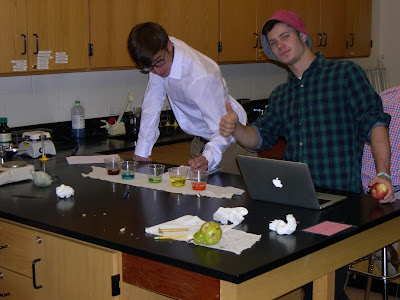The Forensic Science classes have been examining, documenting and photographing a crime scene in their current unit of study. The students work the scene in teams of two to three students. Each team is given one eighty minute period to document the scene by itemizing, describing and photographing the evidence found in the class room. When completed they will write an investigative report that will include they hypothesis as to what the evidence indicated occurred in the room.
As they move through the scene they will prepare four different crime scene forms:
[1]
Crime Scene Disposition Form - in which each piece of physical evidence is assigned a unique identifying number/letter, described and earmarked for specific tests (fingerprints, DNA, drugs etc.) when the evidence is gathered and returned to the lab.
[2]
Crime Scene Measurement Form - in which each piece of evidence's position is precisely located by measuring its distance from two points in the room.
[3]
Crime Scene Photograph Form - in which each piece of evidence is photographed and that photograph is hyperlinked to the evidence description in the log.
[4]
Crime Scene Rough Sketch Form - in which a bird's eye, not to scale replica of the crime scene and all the evidence is produced.
 |
| Bloody foot prints leading from the table where an altercation occurred. |
 |
| Bullet casing. |
 |
| Left side of table where the homicide victim was found seated. |
 |
| Right side of table where the homicide victim was found seated. |
 |
| Spent projectile on window sill behind homicide victim. |
 |
| Robert catalogs the physical evidence on the table, while Daniel is entering his data into the digital forms. |
 |
| Jack was given the task of measuring the positions of all the physical evidence. Daniel is assigning item numbers to the evidence, writing descriptions and deciding on what the disposition of the evidence should be once it arrives in the lab. |
 |
| Jack and Robert examine the ledge behind the homicide victim |
 |
| Sophia and Jack examine the evidence on the table before the homicide victim. |



































